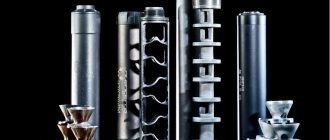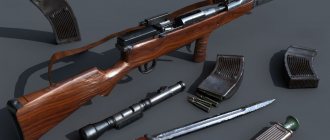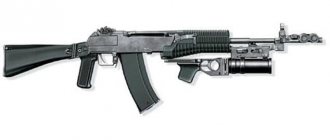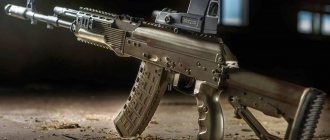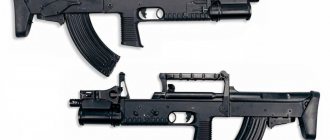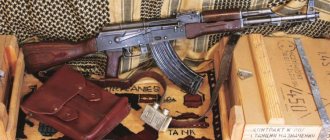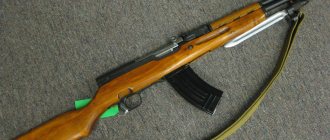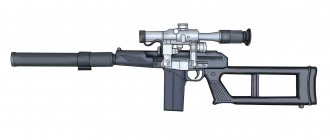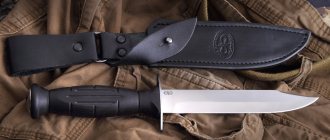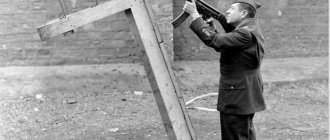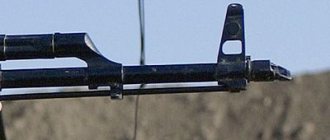This term has other meanings, see Shaft (meanings).
| AS "Val" | |
| Special silent machine gun "Val" | |
| Type | machine |
| A country | USSR USSR→ Russia Russia |
| Service history | |
| Years of use | 1987 - present |
| Adopted | 1980 |
| In service | USSR, Russia, Georgia, Kazakhstan, Armenia |
| Wars and conflicts | First Chechen War, Second Chechen War, War in South Ossetia (2008), Armed conflict in eastern Ukraine. |
| Production history | |
| Constructor | P. Serdyukov V. Krasnikov |
| Designed by | early 1980s |
| Manufacturer | TsNIITochmash[1] Tula arms plant[1] |
| Total issued | production continues |
| Options | SR-3 |
| Characteristics | |
| Weight, kg | 2.5 (without a sight and with an empty magazine)[2] 3.54 (with a loaded magazine and a PSO-1 sight) 4.95 (with a loaded magazine and a 1-PN-51 sight)[3] |
| Length, mm | 875/615 with stock extended/folded[2] |
| Barrel length, mm | 200 (without muffler) |
| Width, mm | 40[3] |
| Height, mm | 205[3] |
| Cartridge | 9×39 mm (SP-5, SP-6, PAB-9)[2] |
| Caliber, mm | 9 |
| Work principles | removal of powder gases, rotary bolt |
| Rate of fire, rounds/min | 800 (technical)[4] 30 (single combat)[4] 90 (burst combat)[4] |
| Initial bullet speed, m/s | 280—295[4] |
| Sighting range, m | 420 (open sight)[4] 400 (optical PSO-1-1)[2] 300 (with night sight 1-PN-51)[3] |
| Type of ammunition | box magazine for 20 rounds[2] (using VSS magazines for 10 rounds and SR-3M for 30 rounds is allowed) |
| Aim | sector, it is possible to install various collimator, optical and night sights |
| AS "Val" on Wikimedia Commons | |
AS "Val"
(
A
assault
rifle , Index GRAU -
6P30
) is a silent assault rifle developed at the Klimov TsNIITochmash by designers P. Serdyukov and V. Krasnikov in the second half of the 1980s on the basis of the VSS silent sniper rifle. “Val” and “VSS” are visually similar and 70% unified.
Also part of this silent weapon system was a special self-loading pistol (PSS) and a shooting scout knife (SRS)[1].
Story
Until the 1970s, special forces units of the USSR mainly used modified models of small arms and grenade launchers for general military purposes, equipped with silencers and using special cartridges with subsonic bullet speeds. As an example, we can cite the “Silence” complexes based on the AKM and the “Canary” based on the AKS74U, as well as pistols and APB. However, such solutions had their drawbacks (for example, a significant increase in the size of pistols with silencers, a sharp decrease in the effective firing range of machine guns with PBS-1 and its limited resource), therefore, in parallel, special samples of narrowly targeted purposes that could provide greater secrecy in the actions of special forces[1].
Conflicting tactical and technical requirements for a sniper rifle and an assault rifle, put forward by various departments, caused delays in work, and by 1983 the requirements were agreed upon only for a sniper rifle. The TTZ for the assault rifle was approved only two years later, but it also acquired key significance for the program for the development of a sniper rifle, since it had an increased value of lethality (it was necessary to ensure the destruction of manpower in 6B2 body armor at a distance of 400 m, while in the TTZ for a sniper rifle, only an army helmet was mentioned). As a result of this, the sniper rifle was completely redesigned for the new 9x39 mm cartridge, and on its basis the “Val” assault rifle was created (which became the basis for the development of the small-sized SR-3 “Vikhr” assault rifle)[1].
Description
The special “Val” automatic machine is built on the basis of gas-operated automatics with a long working stroke of the gas piston. The gas piston is located above the barrel and is rigidly connected to the bolt frame. The inside of the piston is hollow, and a return spring enters it at its front end. USM - striker type. The barrel is locked using a rotating bolt, which has 6 lugs, through cutouts in the receiver. The receiver is milled from steel. Compared to stamping, this method increases the rigidity of the structure, but also increases the weight and cost of production. To protect against corrosion, steel is blued. There are four rows of inclined holes in the walls of the barrel, ensuring uniform removal of powder gases (some of the gases are discharged into the muffler chamber even when the bullet moves along the barrel).
The stock is tubular, folding to the left, metal, strong enough for use in close combat, and when folded does not interfere with shooting. The rough surface of the pistol grip allows it to be held firmly, which is also facilitated by the shape of the grip itself.[5] The pistol grip, forend and double-row magazines are plastic. The built-in muffler also acts as a flame arrester.[4] Thanks to it and cartridges with subsonic speed, the sound pressure level when fired is 130.[6] The fire mode selector is located in the rear of the trigger guard, and the safety and reloading handle are on the right. Despite the improvements in ergonomics, in comparison with the Kalashnikov assault rifle, the “Val” cannot be called a completely ambidextrous weapon: the shooter has to remove his hand from the pistol grip in order to remove the weapon from the safety or move the bolt handle (to carry out these operations, you have to tilt and turn it with your left hand machine). Also worth noting as disadvantages is the clanging of the shutter and cases of bullet damage when fired.
It uses special 9-mm subsonic cartridges SP-5 and SP-6. The bullet of the SP-5 sniper cartridge (with a steel core) penetrates class 2 body armor or 6-mm steel sheet at a distance of 100 m, and 2-mm - at the entire aimed shooting distance, while retaining energy sufficient to defeat a hidden enemy. The SP-6 armor-piercing cartridge with an enlarged core made of hardened steel is capable of disabling a car and even lightly armored vehicles. It penetrates 8-mm steel sheet at a distance of 100 m, and 5-mm steel sheet or class 3 body armor at the entire aimed shooting distance. These indicators are comparable to those of standard cartridges of 5.56 mm and 5.45 mm calibers, which have several times greater muzzle energy.[4]
Sights include a front sight and a sector sight, marked from 25 to 400 meters, mounted on the muffler casing. In addition, on the left wall of the receiver there is a bar for attaching brackets for optical day (for example, PSO-1M) and night (for example, 1-PN-51) sights, making it possible to recognize targets at a distance of up to 300 m.
Disassembled into its main components (receiver with barrel, automatics, trigger and forend, muffler with sighting devices, stock), the machine gun is transported in a special case along with sights and magazines. Assembly takes from 30 to 60 seconds depending on the shooter's preparation.
Silent shooting
The noiselessness of the device is determined by several factors.
1. The speed of the bullet when leaving the barrel is reduced, it is subsonic (up to 330 meters per second). At this speed, the bullet does not create a ballistic wave - the main cause of noise when fired.
2. A special muffler is installed on the barrel. It absorbs part of the powder gases. Their release usually creates a shock wave, but the Vala muffler has a special chamber where the powder gases are discharged, so the noise level is reduced.
For the 1980s, this development is revolutionary, because then it was difficult to achieve lower noise levels. But there is another problem related to the noise level - loud shutter clanging.
Incomplete disassembly
- Release the magazine while pressing the magazine latch.
- Separate the muffler with the recessed latch of the muffler housing.
- Separate the separator from the muffler body while releasing the separator latch.
- Separate the separator spring.
- Separate the receiver cover with the cover lock recessed.
- Separate the return mechanism by pushing the mechanism stop forward.
- Separate the striker by moving it to the rearmost position.
- Separate the bolt frame with the bolt, moving them to the rearmost position.
- Separate the bolt from the bolt frame.
- Separate the forend with the recessed latch
- Separate the tube by turning it clockwise until it aligns with the slot of the receiver.
Assembly is carried out in reverse order.
Equipment
- Carrying case.
- Pencil case body.
- Pencil case cover.
- Screwdriver.
- Punch.
- Ruff.
- Wiping.
- Scraper knife.
- Shop.
- Ramrod.
- Oil can.
- Sight case.
- Bag for scope and magazines.
- The shops.
- Bag for spare parts.
- Belt for carrying weapons.[7]
Each machine is equipped with an individual (single) set of spare parts and accessories (SPTAs). It is designed to ensure the operation of the weapon and maintain it in good condition. The ZIP-O rifle includes:
- cleaning rod - has a ring on one side and a thread on the other for screwing on a wiper, brush or scraper.
- The oil can is standard, from AKM assault rifles.
- accessory - standard, from AKM assault rifles.
- scraper - designed to remove powder deposits from the inner surface of the muffler body. For cleaning, it is screwed onto the cleaning rod. During the operation of the weapon, the design of the scraper was changed.
- knife - used to remove powder deposits from the surfaces of the separator, barrel and gas piston. The knife has two blades - for cleaning the outer surfaces of the barrel and gas piston, and for cleaning the separator.
- six 20-round magazines,
- belt.
The machine's installation equipment includes:
- case for carrying the machine gun,
- scope carrying bag
- vest for placing and carrying - six magazines, two flares, or one flare and a knife, three hand grenades, a PSS pistol and a spare magazine for it.
The machine's magazines are interchangeable with those of the VSS Vintorez.
Operating countries
- USSR USSR - in 1987 it entered service with special forces units and the Ministry of Internal Affairs of the USSR [ source not specified 46 days
]. - Russia Russia is in service with special forces units of the Russian Armed Forces, GRU, Ministry of Internal Affairs, FSB, FSKN.
- Georgia Georgia is in service with a group of special forces of the Georgian Armed Forces[8][ not in the source
]. - Kazakhstan Kazakhstan is in service with special forces [ source not specified 625 days
]. - Armenia Armenia is in service with special forces [ source not specified 46 days
].
Use in combat
At the moment, the weapon is used in four post-Soviet countries. These are Russia, Georgia, Armenia and Kazakhstan.
“Val” entered service in 1987 in the USSR, but after the rapid collapse of the state, the bulk of the machine guns passed to Russia. In the Russian Federation, this design is in service with many major security forces, the main ones of which are the Ministry of Internal Affairs, the FSB, the Armed Forces of the Russian Federation, and the GRU.
The weapon is used as an element of equipment for reconnaissance fighters. Main applications:
- Being in ambush. Defeat opponents at a distance of 400 m, enemy equipment at a distance of 100 m.
- Close combat. Point-blank bursts allow you to penetrate protective helmets and class 2 body armor.
- Close hand-to-hand combat. The folding stock can be used to hit the enemy's head and other vulnerable areas. Steel has enough weight and increased strength to inflict serious traumatic brain injury and incapacitate an opponent.
It is convenient to use the product on the battlefield, where there are rifles with magazines of a similar type: the Vala magazine with 20 rounds can be completely replaced with a Vintorez rifle magazine with 10 rounds. cartridges.
In Georgia, Kazakhstan and Armenia, this weapon is in service with special units, including the official units of the Georgian Armed Forces.
Advantages and disadvantages
Advantages
- Small dimensions and weight.
- The bullet has an acceptable muzzle energy (665 J), and thanks to its large mass (16.1 g), it retains it for a long time. So, at a distance of 400 m it is about 500 J, which provides high penetration and lethal effect.
- Accuracy of fire at a distance of up to 300 m is quite satisfactory.
- The machine has a simple design and is easy to disassemble. When disassembled, it fits in a case.
- On the left side of the receiver there is a universal seat for mounting optical and night sights of various types.
- The muffler integrated with the barrel provides good suppression of sound waves and flash flames. The superimposition of residual sound on the surrounding noise makes the sound of a gunshot inaudible.
- The muffler has no replaceable elements, so it is durable.
- The fire mode switch is located next to the trigger; switching it is possible without removing your hand from the fire control handle.
- The use of several types of cartridges - SP-5, SP-6 ensures both high-precision shooting and hitting targets in individual armor protection or located behind an obstacle (for example, in a car).[9][ unauthorized source?
]
Flaws
- Low effective firing range (no more than 400 m).
- Shutter clanging when firing.
- The metal stock is not comfortable enough.
- The magazine capacity is insufficient.
- The steepness of the bullet's flight path makes it difficult to choose an aiming point.
- To turn off the safety, you must lift your hand from the fire control handle.
- The dimensions of the muffler are too large, while at the same time the rigidity of its separator is low. The muffler assembly is not locked securely or freely enough. There are known cases of damage to the separator by a bullet when fired.
- The cartridges used are in short supply.
Cartridges for the VSS rifle and the AC assault rifle
| SP-5 (sniper) | SP-6 (armor-piercing) |
For firing from a VSS rifle and an AS assault rifle, special SP-5 (sniper) and SP-6 (increased penetration, they are also often called armor-piercing) cartridges can be used. All cartridges have the same dimensions and consist of a bullet, a cartridge case, a propellant charge and an igniter primer. Their main feature is the design of the bullets.
| The bullet of the SP-5 cartridge (fig. on the right) consists of a steel and lead core placed in a bimetallic shell. The steel core, to increase the penetrating effect of the bullet, is placed in its nose. The lead core not only gives the bullet the necessary mass, but also ensures that it cuts into the rifling of the barrel. The shape of the bullet, 36 mm long, provides it with good ballistic properties when flying at subsonic speeds. The bullets of SP-5 cartridges do not have a distinctive color. Packaging cardboard boxes for 10 rounds are marked “Sniper”. |
| The bullet of the SP-6 cartridge (Fig. on the right) has a different design and consists of a steel core, a lead jacket and a bimetallic shell. The hardened steel core of this bullet is much longer than that of the SP-5 cartridge bullet: it fills the entire cavity of the bimetallic shell. The nose of the bullet protrudes from the shell. Due to its design, the bullet of the SP-6 cartridge has a higher penetrating effect than the BULLET of the SP-5 cartridge. The tip of the SP-6 cartridge bullet is painted black. The packaging cartons for these cartridges have a distinctive black stripe. |
| Characteristics | SP-5 | SP-6 |
| Chuck length, mm | 56,2 | 56 |
| Sleeve length, mm | 39 | 39 |
| Bullet length, m | 36 | 42 |
| Cartridge weight, g | 23,2 | 23,0 |
| Bullet weight, g | 16,2 | 16,0 |
| Initial bullet speed, m/s | 290 | 290 |
In popular culture
- In films and television series: In the film War, the hero of Alexei Chadov uses VAL with a PSO-1-1 optical sight during an attack on a militant camp, and then the hero of Sergei Bodrov while leaving the same camp.
- Present in the series Spetsnaz, in “ Doc
” and “
Yakut
” (3rd episode) - In the film "Personal Number" it was used by Russian special forces.
- Present in the series Desantura, by Lieutenant Colonel Anatoly Loschilin in the 7th episode, by Senior Lieutenant Kudinov in the 8th episode and by the commander of a militant detachment in the same episode.
- ACE 2 (modification for the game ArmA 2)
Notes
- ↑ 12345
"Small arms of Russia". Special issue 1 dedicated to VSS Vintorez and AS Val. V. Korablin and V. Krasnikov, “Technology of Youth” - ↑ 12345
description of AS "Val" on the developer's website - ↑ 1234
Article “AS Automatic “Val”” on the website of the magazine “Brother” - ↑ 1234567
Article “Weapons of special operations” on the website of the magazine “Brother” - Special silent automatic machine AS Val (Russia)
- Description of AS "Val" Archived copy dated February 28, 2009 on the Wayback Machine on the website world.guns.ru
- Special automatic machine (AS) “Val”
- SSSN of Georgia Archived copy dated November 28, 2010 on the Wayback Machine on the website spec-naz.org
- Automatic AS Val - Characteristics, Description, Photo. | LiveGuns Archived January 6, 2014 on the Wayback Machine
- AS Val – Internet Movie Firearms Database – Guns in Movies, TV and Video Games
Performance characteristics of the "Val" assault rifle
The main tactical and technical characteristics of a silent machine gun can be summarized in the following table:
| Caliber | 9 mm (real bullet diameter 9.25 mm) |
| Length | 650-875 mm (depending on the position of the butt) |
| Height | 205 mm |
| Width | 40 mm |
| Sighting line length | 310 mm |
| Weight | 2.5-2.96 kg (without cartridges and loaded) |
| Ammunition | 20 or 10 round magazines |
| Maximum aimed firing range | 400 meters |
The standard ammunition load consists of 6 magazines, however, the low weight of the cartridges allows the soldier to take a larger supply with him. The performance characteristics of the “Val” are very close to those of the “Vintorez”; if there are any differences, they are determined by different modes of application.
